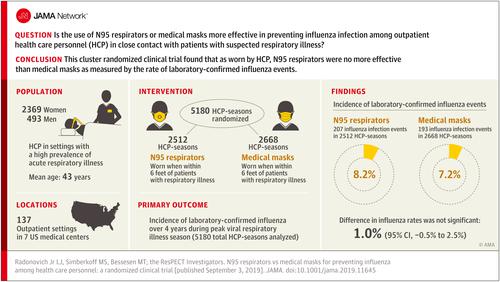Our official English website, www.x-mol.net, welcomes your
feedback! (Note: you will need to create a separate account there.)
N95 Respirators vs Medical Masks for Preventing Influenza Among Health Care Personnel
JAMA ( IF 63.1 ) Pub Date : 2019-09-03 , DOI: 10.1001/jama.2019.11645 Lewis J Radonovich 1 , Michael S Simberkoff 2, 3 , Mary T Bessesen 4, 5 , Alexandria C Brown 6 , Derek A T Cummings 7, 8 , Charlotte A Gaydos 9 , Jenna G Los 9 , Amanda E Krosche 9, 10 , Cynthia L Gibert 11, 12 , Geoffrey J Gorse 13, 14 , Ann-Christine Nyquist 5, 15 , Nicholas G Reich 6 , Maria C Rodriguez-Barradas 16, 17 , Connie Savor Price 5, 18 , Trish M Perl 8, 19 ,
JAMA ( IF 63.1 ) Pub Date : 2019-09-03 , DOI: 10.1001/jama.2019.11645 Lewis J Radonovich 1 , Michael S Simberkoff 2, 3 , Mary T Bessesen 4, 5 , Alexandria C Brown 6 , Derek A T Cummings 7, 8 , Charlotte A Gaydos 9 , Jenna G Los 9 , Amanda E Krosche 9, 10 , Cynthia L Gibert 11, 12 , Geoffrey J Gorse 13, 14 , Ann-Christine Nyquist 5, 15 , Nicholas G Reich 6 , Maria C Rodriguez-Barradas 16, 17 , Connie Savor Price 5, 18 , Trish M Perl 8, 19 ,
Affiliation

|
Importance
Clinical studies have been inconclusive about the effectiveness of N95 respirators and medical masks in preventing health care personnel (HCP) from acquiring workplace viral respiratory infections. Objective
To compare the effect of N95 respirators vs medical masks for prevention of influenza and other viral respiratory infections among HCP. Design, Setting, and Participants
A cluster randomized pragmatic effectiveness study conducted at 137 outpatient study sites at 7 US medical centers between September 2011 and May 2015, with final follow-up in June 2016. Each year for 4 years, during the 12-week period of peak viral respiratory illness, pairs of outpatient sites (clusters) within each center were matched and randomly assigned to the N95 respirator or medical mask groups. Interventions
Overall, 1993 participants in 189 clusters were randomly assigned to wear N95 respirators (2512 HCP-seasons of observation) and 2058 in 191 clusters were randomly assigned to wear medical masks (2668 HCP-seasons) when near patients with respiratory illness. Main Outcomes and Measures
The primary outcome was the incidence of laboratory-confirmed influenza. Secondary outcomes included incidence of acute respiratory illness, laboratory-detected respiratory infections, laboratory-confirmed respiratory illness, and influenzalike illness. Adherence to interventions was assessed. Results
Among 2862 randomized participants (mean [SD] age, 43 [11.5] years; 2369 [82.8%]) women), 2371 completed the study and accounted for 5180 HCP-seasons. There were 207 laboratory-confirmed influenza infection events (8.2% of HCP-seasons) in the N95 respirator group and 193 (7.2% of HCP-seasons) in the medical mask group (difference, 1.0%, [95% CI, -0.5% to 2.5%]; P = .18) (adjusted odds ratio [OR], 1.18 [95% CI, 0.95-1.45]). There were 1556 acute respiratory illness events in the respirator group vs 1711 in the mask group (difference, -21.9 per 1000 HCP-seasons [95% CI, -48.2 to 4.4]; P = .10); 679 laboratory-detected respiratory infections in the respirator group vs 745 in the mask group (difference, -8.9 per 1000 HCP-seasons, [95% CI, -33.3 to 15.4]; P = .47); 371 laboratory-confirmed respiratory illness events in the respirator group vs 417 in the mask group (difference, -8.6 per 1000 HCP-seasons [95% CI, -28.2 to 10.9]; P = .39); and 128 influenzalike illness events in the respirator group vs 166 in the mask group (difference, -11.3 per 1000 HCP-seasons [95% CI, -23.8 to 1.3]; P = .08). In the respirator group, 89.4% of participants reported "always" or "sometimes" wearing their assigned devices vs 90.2% in the mask group. Conclusions and Relevance
Among outpatient health care personnel, N95 respirators vs medical masks as worn by participants in this trial resulted in no significant difference in the incidence of laboratory-confirmed influenza. Trial Registration
ClinicalTrials.gov Identifier: NCT01249625.
中文翻译:

N95 呼吸器与医用口罩在预防医护人员流感方面的比较
重要性 对于 N95 呼吸器和医用口罩在预防医护人员 (HCP) 感染工作场所病毒性呼吸道感染方面的有效性,临床研究尚未得出结论。目的 比较 N95 口罩与医用口罩预防医护人员流感和其他病毒性呼吸道感染的效果。设计、设置和参与者 2011 年 9 月至 2015 年 5 月期间,在美国 7 个医疗中心的 137 个门诊研究中心进行了一项整群随机实用有效性研究,最终随访时间为 2016 年 6 月。每年 4 年,为期 12 周在病毒性呼吸道疾病高峰期,每个中心内的门诊点(集群)配对并随机分配到 N95 呼吸器组或医用口罩组。干预措施 总体而言,189 个集群中的 1993 名参与者被随机分配佩戴 N95 呼吸器(2512 个 HCP 观察季节),191 个集群中的 2058 名参与者在接近呼吸道疾病患者时被随机分配佩戴医用口罩(2668 个 HCP 季节)。主要结果和措施 主要结果是实验室确诊的流感的发病率。次要结局包括急性呼吸道疾病的发生率、实验室检测到的呼吸道感染、实验室确诊的呼吸道疾病和流感样疾病。评估了干预措施的依从性。结果 在 2862 名随机参与者(平均 [SD] 年龄,43 [11.5] 岁;2369 名女性 [82.8%])中,2371 名完成了研究,占 5180 个 HCP 季节。N95 呼吸器组有 207 起实验室确诊的流感感染事件(HCP 季节的 8.2%),医用口罩组有 193 起(HCP 季节的 7.2%)(差异为 1.0%,[95% CI,-0.5] % 至 2.5%];P = .18)(调整后的比值比 [OR],1.18 [95% CI,0.95-1.45])。呼吸器组发生了 1556 起急性呼吸道疾病事件,而面罩组发生了 1711 起(差异为每 1000 个 HCP 季节 -21.9 起 [95% CI,-48.2 至 4.4];P = .10);呼吸器组有 679 例实验室检测到的呼吸道感染,而面罩组有 745 例(差异为每 1000 个 HCP 季节 -8.9 例,[95% CI,-33.3 至 15.4];P = .47);呼吸器组发生 371 起实验室确诊的呼吸道疾病事件,而面罩组发生 417 起(差异为每 1000 个 HCP 季节 -8.6 起 [95% CI,-28.2 至 10.9];P = .39);呼吸器组发生 128 起流感样疾病事件,而面罩组发生 166 起(差异为每 1000 个 HCP 季节 -11.3 起 [95% CI,-23.8 至 1.3];P = 0.08)。在呼吸器组中,89.4% 的参与者表示“总是”或“有时”佩戴分配的设备,而在面罩组中这一比例为 90.2%。结论和相关性 在门诊医护人员中,本试验参与者佩戴 N95 呼吸器与医用口罩相比,实验室确诊流感的发生率没有显着差异。试验注册 ClinicalTrials.gov 标识符:NCT01249625。
更新日期:2019-09-03
中文翻译:

N95 呼吸器与医用口罩在预防医护人员流感方面的比较
重要性 对于 N95 呼吸器和医用口罩在预防医护人员 (HCP) 感染工作场所病毒性呼吸道感染方面的有效性,临床研究尚未得出结论。目的 比较 N95 口罩与医用口罩预防医护人员流感和其他病毒性呼吸道感染的效果。设计、设置和参与者 2011 年 9 月至 2015 年 5 月期间,在美国 7 个医疗中心的 137 个门诊研究中心进行了一项整群随机实用有效性研究,最终随访时间为 2016 年 6 月。每年 4 年,为期 12 周在病毒性呼吸道疾病高峰期,每个中心内的门诊点(集群)配对并随机分配到 N95 呼吸器组或医用口罩组。干预措施 总体而言,189 个集群中的 1993 名参与者被随机分配佩戴 N95 呼吸器(2512 个 HCP 观察季节),191 个集群中的 2058 名参与者在接近呼吸道疾病患者时被随机分配佩戴医用口罩(2668 个 HCP 季节)。主要结果和措施 主要结果是实验室确诊的流感的发病率。次要结局包括急性呼吸道疾病的发生率、实验室检测到的呼吸道感染、实验室确诊的呼吸道疾病和流感样疾病。评估了干预措施的依从性。结果 在 2862 名随机参与者(平均 [SD] 年龄,43 [11.5] 岁;2369 名女性 [82.8%])中,2371 名完成了研究,占 5180 个 HCP 季节。N95 呼吸器组有 207 起实验室确诊的流感感染事件(HCP 季节的 8.2%),医用口罩组有 193 起(HCP 季节的 7.2%)(差异为 1.0%,[95% CI,-0.5] % 至 2.5%];P = .18)(调整后的比值比 [OR],1.18 [95% CI,0.95-1.45])。呼吸器组发生了 1556 起急性呼吸道疾病事件,而面罩组发生了 1711 起(差异为每 1000 个 HCP 季节 -21.9 起 [95% CI,-48.2 至 4.4];P = .10);呼吸器组有 679 例实验室检测到的呼吸道感染,而面罩组有 745 例(差异为每 1000 个 HCP 季节 -8.9 例,[95% CI,-33.3 至 15.4];P = .47);呼吸器组发生 371 起实验室确诊的呼吸道疾病事件,而面罩组发生 417 起(差异为每 1000 个 HCP 季节 -8.6 起 [95% CI,-28.2 至 10.9];P = .39);呼吸器组发生 128 起流感样疾病事件,而面罩组发生 166 起(差异为每 1000 个 HCP 季节 -11.3 起 [95% CI,-23.8 至 1.3];P = 0.08)。在呼吸器组中,89.4% 的参与者表示“总是”或“有时”佩戴分配的设备,而在面罩组中这一比例为 90.2%。结论和相关性 在门诊医护人员中,本试验参与者佩戴 N95 呼吸器与医用口罩相比,实验室确诊流感的发生率没有显着差异。试验注册 ClinicalTrials.gov 标识符:NCT01249625。











































 京公网安备 11010802027423号
京公网安备 11010802027423号